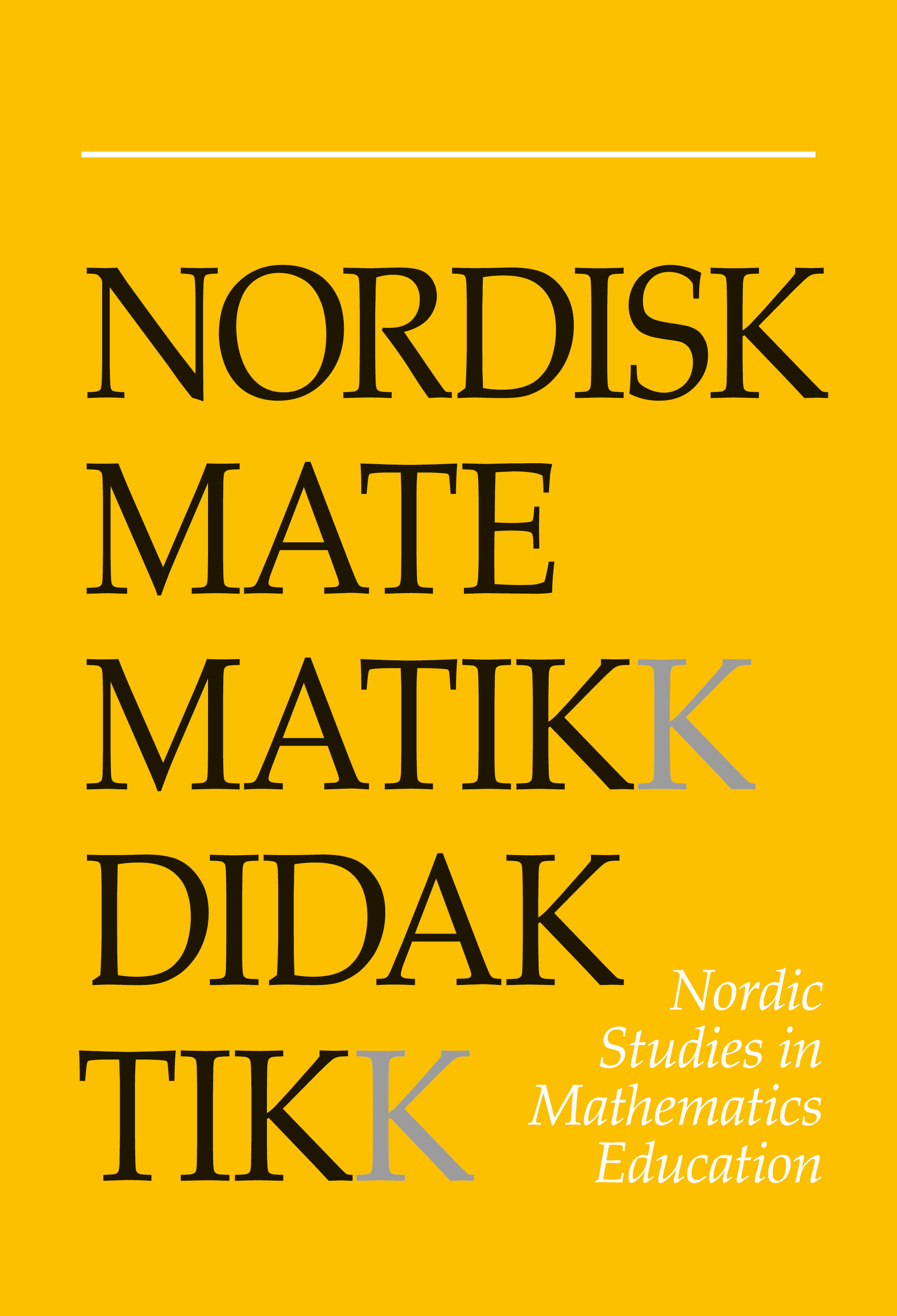Teachers’ use of resources in and for mathematics teaching
DOI:
https://doi.org/10.7146/nomad.v20i3-4.148698Abstract
Over the past decades the amount of available resources for mathematics teaching has vastly increased, in particular the availability of resources on the web. However, we know very little about how teachers select and use the available resources. In this paper we investigate how four primary school teachers used curriculum resources in and for their mathematics teaching. Grounded in a case study approach, we have analysed lessons, teacher interviews, and documents they used for their lesson preparation and instruction. Subsequently, we identified five ”usage categories”: (1) resources to manage the teaching objectives; (2) resources to ”inspire” teaching; (3) resources for student work; (4) resources to adapt the teaching to indivi-dual students’ needs (differentiation); and (5) resources to organize the teaching. In this article we explain and discuss these five categories, and argue that the ”lens of resources” offers an opportune window into teachers’ work, in particular their work as mathematics teachers.
References
Adler, J. (2000). Conceptualising resources as a theme for teacher education. Journal of Mathematics Teacher Education, 3 (3), 205-224. https://doi.org/10.1023/A:1009903206236
Adler, J. (2012). Knowledge resources in and for school mathematics teaching. In G. Gueudet, B. Pepin & L. Trouche (Eds.), From text to "lived" resources: mathematics curriculum materials and teacher development (pp. 3-22). Dordrecht: Springer.
Alseth, B., Nordberg, G. & Røsseland, M. (2008a). Multi 7a: lærerens bok. Oslo: Gyldendal Norsk Forlag AS.
Alseth, B., Nordberg, G. & Røsseland, M. (2008b). Multi 7a: grunnbok. Oslo: Gyldendal Norsk Forlag AS.
Brown, M. W. (2009). The teacher-tool relationship: theorizing the design and use of curriculum materials. In J. T. Remillard, B. A. Herbel-Eisenmann & G. M. Lloyd (Eds.), Mathematics teachers at work: connecting curriculum materials and classroom instruction (pp. 17-36). New York: Routledge.
Cohen, L., Morrison, K. & Manion, L. (2007). Research methods in education (6th ed.). London: Routledge. https://doi.org/10.4324/9780203029053
Cohen, D. K., Raudenbush, S. W. & Ball, D. L. (2003). Resources, instruction and research. Educational Evaluation and Policy Analysis, 25 (2), 119-142. https://doi.org/10.3102/01623737025002119
Creswell, J. W. (1998). Qualitative inquiry and research design: choosing among five traditions. Thousand Oaks: Sage.
Directorate for Education and Training (2013). Curriculum for the common core subject of mathematics. Oslo: Author. Retrieved from http://www.udir.no/kl06/mat1-04/Hele/Kompetansemaal/kompetansemal-etter-7.-arssteget/?lplang=eng
Fan, L. (2013). Textbook research as scientific research: towards a common ground on issues and methods of research on mathematics textbooks. ZDM - The International Journal of Research in Mathematics Education, 45 (5), 765-77. https://doi.org/10.1007/s11858-013-0530-6
Galen, F. van, Feijs, E., Figueiredo, N., Gravemeijer, K., Herpen, E. van & Keijzer, R. (2008). Fractions, percentages, decimals and proportions. A learning- teaching trajectory for grade 4,5 and 6. Rotterdam: Sense Publishers. https://doi.org/10.1163/9789460911422
Gueudet, G., Pepin, B. & Trouche, L. (2013). Collective work with resources: an essential dimension for teacher documentation. ZDM - The International Journal of Mathematics Education. 45 (7), 1003-1016. https://doi.org/10.1007/s11858-013-0527-1
Gueudet, G., Pepin, B. & Trouche, L. (2012). Introduction. In G. Gueudet, B. Pepin & L. Trouche (Eds.), From text to "lived" resources: mathematics curriculum materials and teacher development (pp. ix-xiii). Dordrecht: Springer. https://doi.org/10.1007/978-94-007-1966-8
Gueudet, G. & Trouche, L. (2009). Towards new documentation systems for mathematics teachers? Educational Studies in Mathematics, 71 (3), 199-218. https://doi.org/10.1007/s10649-008-9159-8
Gueudet, G. & Trouche, L. (2012). Teachers' work with resources: documentational geneses and professional geneses. In G. Gueudet, B. Pepin & L. Trouche (Eds.), From text to "lived" resources: mathematics curriculum materials and teacher development (pp. 23-42). Dordrecht: Springer. https://doi.org/10.1007/978-94-007-1966-8_2
Juuhl, G. K., Hontvedt, M. & Skjelbred, D. (2010). Læremiddelforsking etter LK06: eit kunnskapsoversyn. Oslo: Utdanningsdirektoratet. Retrieved from http://www.udir.no/Tilstand/Forskning/Rapporter/Hogskoler/Laremiddelforsking-etter-Kunnskapsloftet---rapport-2010/
Klette, K. (2007). Bruk av arbeidsplaner i skolen - et hovedverk for å realisere tilpasset opplæring? Norsk Pedagogisk Tidsskrift, 91 (4), 344-358. https://doi.org/10.18261/ISSN1504-2987-2007-04-08
Kunnskapsdepartementet (1998). Lov om grunnskolen og den vidaregåande opplæringa. Retrieved from https://lovdata.no/dokument/NL/lov/1998-07-17-61
Ollerton, M. (2001). Inclusion, learning and teaching mathematics: beliefs and values. In P. Gates (Ed.), Issues in mathematics teaching (pp. 261-276). London: Routledge/Falmer.
Pedersen, B. B., Pedersen, P. I., Skoogh, L., Johansson, H. & Ahlström, R. (2006). Abakus: lærerens ressursbok 7A. Oslo: H. Aschehoug & Co. (W. Nygaard).
Pepin, B. & Gueudet, G. (2014). Curricular resources and textbooks in mathematics education. In S. Lerman (Ed.), Encyclopedia of mathematics education. Dordrecht: Springer Science+Business. https://doi.org/10.1007/978-94-007-4978-8_40
Pepin, B., Gueudet, G. & Trouche, L. (2013a). Re-sourcing teachers' work and interactions: a collective perspective on resources, their use and transformations. ZDM - The International Journal of Mathematics Education. 45 (7): 929-943. https://doi.org/10.1007/s11858-013-0534-2
Pepin, B., Gueudet, G. & Trouche, L. (2013b). Investigating curricular documents and practices with respect to educational traditions in France and Norway: textbooks at the boundary between policy and practice. ZDM - The International Journal of Mathematics Education, 45 (6), 685-698. https://doi.org/10.1007/s11858-013-0526-2
Pepin, B. & Haggarty, L. (2001). Mathematics textbooks and their use in English, French and German classrooms. Zentralblatt für Didaktik der Mathematik, 33 (5), 158-175. https://doi.org/10.1007/BF02656616
Remillard, J. T. (1999). Curriculum materials in mathematics education reform: a framework for examining teachers' curriculum development. Curriculum Inquiry, 29 (3), 315-342. https://doi.org/10.1111/0362-6784.00130
Remillard, J. T. (2005). Examining key concepts in research on teachers' use of mathematics curricula. Review of Educational Research, 75 (2), 211-246. https://doi.org/10.3102/00346543075002211
Remillard, J. T. (2012). Modes of engagement: understanding teachers' transactions with mathematics curriculum resources. In G. Gueudet, B. Pepin & L. Trouche (Eds.), From text to "lived" resources: mathematics curriculum materials and teacher development (pp. 105-122). Dordrecht: Springer. https://doi.org/10.1007/978-94-007-1966-8_6
Sherin, M. G. & Drake, C. (2009). Curriculum strategy framework: investigating patterns in teachers' use of a reform-based elementary mathematics curriculum. Journal of Curriculum Studies, 41 (4), 467-500. https://doi.org/10.1080/00220270802696115
Thomas, G. (2009). How to do your research project: a guide for students in education and applied social sciences. Los Angeles: Sage.
Valverde, G. A., Bianchi, L. J., Wolfe, R. G., Schmidt, W. H. & Houang, R. T. (2002). According to the book. Dordrecht: Kluwer Academic. https://doi.org/10.1007/978-94-007-0844-0
Downloads
Published
How to Cite
Issue
Section
License

This work is licensed under a Creative Commons Attribution-NonCommercial-ShareAlike 4.0 International License.



